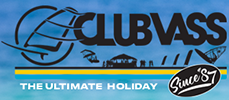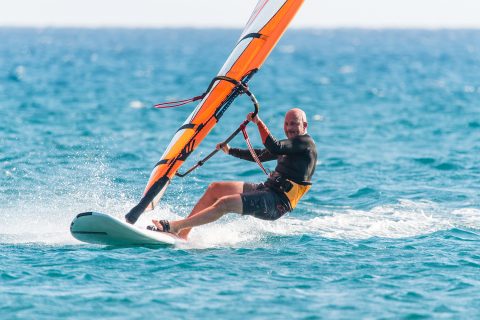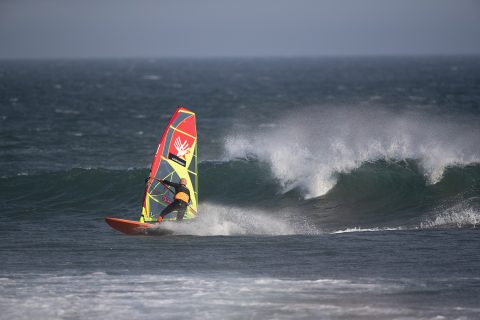JEM HALL
MOVE ON UP – WINDSURFING TECHNIQUE
CHANGING LINES
From our 2021 January / February issue, Jem looks at how a change of your sailing line, be it upwind or downwind can help boost many areas of your sailing, from planing to wave riding, or transitions and jumps.
Photos: Clark Merritt // Eye Sea You
This is often the time of year where we reflect on what has happened in the past and what we may go about changing in the future. As a coach I look to help people change or review their ‘on water’ strategy, their technique and their tuning. Hand on heart, I can say that one of the hardest changes I ask people to embrace is to their sailing lines! Our sailing line is where we are sailing in relation to the wind; in the main this is across the wind, upwind or downwind. A great example of a change in your sailing line might be sailing broader (more off the wind) into the gybe, as opposed to just unhooking across the wind and carving immediately. Another change to our sailing line might be not just sailing upwind a few degrees but really sailing upwind, and taking it from 5 degrees to 20 degrees upwind. A further example of how we change our line is to jump more across the wind, rather than into the wind, this can make a huge difference! I’ll explore now in more detail, how we can make changes to our sailing lines for the better.
- Unhook across the wind for a smoother preparation before you gybe. Photo by Eye Sea You.
Trinity changes
The all-important trinity of skills that will help you to try more moves and have more fun are: plane early; sail fast (from under to overpowered) and get upwind. Here are some simple tips to help improve all three of these skills:
- Go off the wind to plane earlier. Many people passively wait to get planing across the wind, yet if we turn downwind 10 – 30 degrees then we will plane much earlier. Turning more downwind will put more power in the sail to give you the lift required to get going.
- Smaller boards and fins really need to get speed downwind before they get up and going. By turning downwind you will get more speed earlier and as this increases so too does the water flow, and thereby the lift on the fin or fins. Once at a good speed, we can then move to sail across the wind and then head upwind when we have even more lift and power.
- For active early planing, as opposed to passive, get moving off the wind and then go for the front strap and then get down lower to lock the kit down and accelerate and come back to across the wind to hook in. This will make the whole process smoother and make hooking in easier.
- Pump efficiently off the wind out of the straps and then get in the straps, or just the front strap, smoothly, before adding a few more pumps, and then come back to across the wind to hook in, after getting low and comfy.
- Lazy pumping (hooked in) is very efficient to get planing when you have medium power and this is best done a few degrees off the wind. Don’t go too far off the wind as you are hooked in and may catapult. This is covered extensively in my ‘Beginner to Winner’ DVD.
- If you are losing speed, turn off the wind briefly a few degrees to keep your board speed up and fin lifting, and then on the next gust you can make the ground you lost back up.
- If you are getting overpowered, then head upwind. This will help you to sheet the sail in easier and put you on a sailing line where there is less power. You may even spot the gust coming and anticipate this and change your line prior to the surge in power.
- When really overpowered you have to go off the wind in the lulls or you will get blown upwind. If you do not do this then you will have a big downwind run when trying to get home, which can be scary when it is cutting up rough.
- In marginal wind quit your sailing line if it is taking you too far downwind and ‘chug’. Chugging is sailing upwind non-planing, by using / sinking the rail and sheeting the sail out. It is akin to putting money in the upwind bank that can be used when you go downwind to look to get planing. It is not always guaranteed there is more wind out to sea, or in the direction you are heading. If you are in gusty conditions and not planing always chug upwind so you can see gusts and get some upwind advantage. Sailing slowly across the wind is rarely advised. By heading upwind slowly you can see the wind and save energy that you can use for getting planing when you see enough wind heading your way.
- When planing see how high you can go upwind. Don’t just sail upwind, see how far you can push it whilst keeping speed. On smaller gear use the ocean / swell to help you get upwind.
- When sailing upwind, if you experience a drop in power, or see a small lull, then turn downwind a few degrees, this will keep the fin lifting and help you keep planing.
- When sailing upwind if you feel more power from a gust, then head upwind more as this will settle you down and help you put even more money in the upwind bank.
- Identify the side it is easier to get upwind on, e.g. in side-off winds it is very often heading out. On this side go more upwind so you can free off and choose a more downwind sailing line on the side with less power.
People who join my clinics have many different targets, but the main thing they improve is across the whole trinity of basic skills and they really expand their skill range using all of the above tips.
- CAPTION: Changing your sailing line to more off the wind gets you planing earlier and often is the key to making planing gybes. Photo by Eye Sea You.
Transitions
Big improvements in many basic skills can be found by changing our sailing line, especially in transitions such as tacking and gybing. Here are some tips:
- For downwind carving moves, especially learning and improving carve gybes, prepare across the wind and then steer (scissor board) to sail downwind prior to coming forward and carving, whilst still in an outboard sailing position. If we carve straight away we put the board on an edge and this increases friction and thereby loses you speed.
- Unhook across the wind before steering downwind. Do not unhook off the wind, on a downwind sailing line, as it unsettles the board and puts you in the high-risk category for spectacular catapults and front door exits.
- In gybe exits, hook in across the wind after getting some speed off the wind. Hooking in straight after a gybe will depower the rig and also put you in the catapult zone. Furthermore people often stand up and bend their arms to hook in which loses power and mastfoot pressure.
- Duck gybes need a light rig, but one tip is not to go too long before ducking as ironically the rig can get too light. It may then hinge off your back arm with the mast then taking a little dip in the water and sending you out the front door.
- For tacks, go across the wind in your preparation, in order to get a bit of speed and prevent weight on the heels while moving your front hand, unhooking and coming out of the straps. This will keep the board more stable and give you more time to move your hips and feet. It is also easier to get your feet out of the straps when the board is flat and not on an edge.
- For a helicopter tack, gain control front to sail on an upwind sailing line and then open the sail (slide back hand to clew) to get the board off the wind prior to slicing the rig forward and swinging it around the front. Going upwind first helps you control the power front to sail, as there is in effect less wind on the sail.
- CAPTION: Come back to across the wind to prepare for your tacks to keep speed and make the process smoother. Photo by Eye Sea You.
- In onshore winds heading downwind prior to take off will get the sail lighter, give you more options and get your board speed up ready to boost more height. Photo by Eye Sea You.
Waves and jumps
- As you may have felt how much easier it is to plane when heading off the wind to get planing then use this action to catch a wave and get moving for it earlier than you think. Waves move fast and we need to be up to their speed to catch them or they will go underneath us.
- In lighter winds pumping for a wave can be very effective as it get us up to speed quicker so the wave does not disappear underneath us.
- Once you are up on the swell / wave, look up and down it to read the wave so as to identify whether to head upwind or go downwind on it to get to the part of the wave that is best for riding.
- If you are heading upwind on the wave, ‘scissor’ at the top of it to head downwind prior to ‘dropping in’ to the wave and making your turns. This is a massive tip, visualise and understand it. This is a great reason why if we learn to ‘scissor’ in our gybes we can use this skill here, and in many other areas too.
- After dropping down the wave come away from it for both back and frontside wave riding. This will give you speed, give you time to open the sail, change your rails and crucially give you the angle to carve back up the wave. Many people wiggle themselves along the wave way too close to it. A way to ensure this is to focus on just a few turns and not as many as possible.
- Learn to pop / jump across the wind. Sailing upwind will slow you down and with less speed this gives us less time and height to jump, which will make it harder to steer in the air. By scissoring the board in the air you will be rewarded with a smoother landing, and a faster get away as the board will almost skim.
- Get the sail light before jumping if you are well powered. Do this by heading downwind briefly, 5 -10 metres, prior to your jump. This will give you more height, control, and speed in the air and thereby again a safer and smoother landing. Jumping with too much power in the rig is very hard, so if we lose some of this weight in the rig we will have better jumps.
- If you have less power, then up your board speed, and thereby fin lift, to get more height and help the board to release. This is achieved by taking a short downwind sailing line prior to coming back to sailing across the wind on the take off.
- In onshore jumping go off the wind in front of your chosen wave to jump so you have choices as to where to jump on it. This off the wind sailing line will increase your board speed and get the sail light and will also mean you can change direction more easily. For example, by going faster you can carve into the wind without losing much speed, this means you have an option to attack a steeper section of the wave as your take off zone.
- Take a downwind sailing line by at least 20 degrees to learn to forward loop so that you have less far to rotate. This will also help you to be more over the board prior to take off, and on this line you can keep speed with the sail more open. This will then mean the board can be popped more easily as there is less pressure on the mastfoot and then the rig can be sent forwards and across you.
- Come away from the wave to give you time to make better turns and get the space to turn back up the wave. Photo by Clark Merritt.
RRD boards, wetsuits & softwear, Ezzy sails & Black Project fins sponsor Jem Hall. Get him live and direct on one of his highly acclaimed coaching holidays, check out www.jemhall.com for details. You can also follow him on twitter / Facebook / Instagram.







